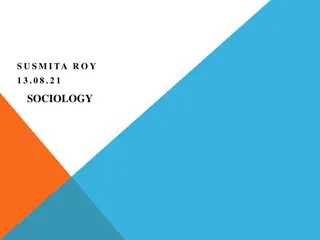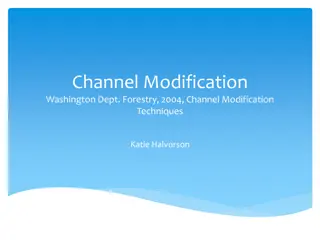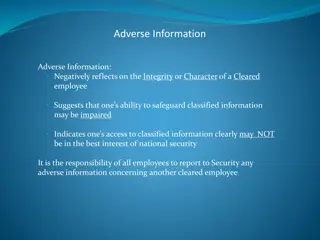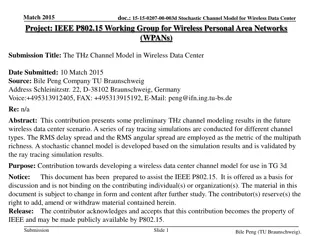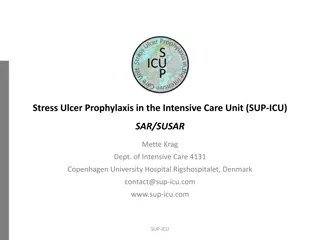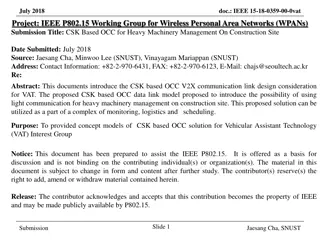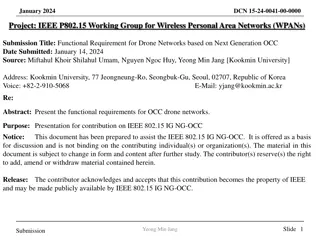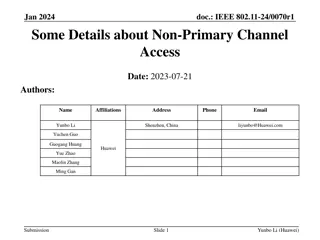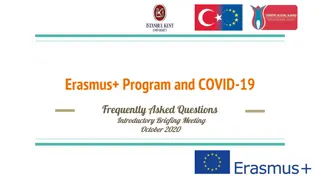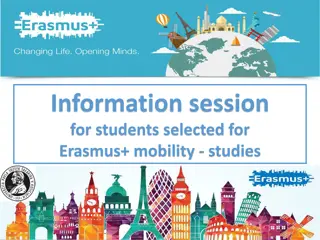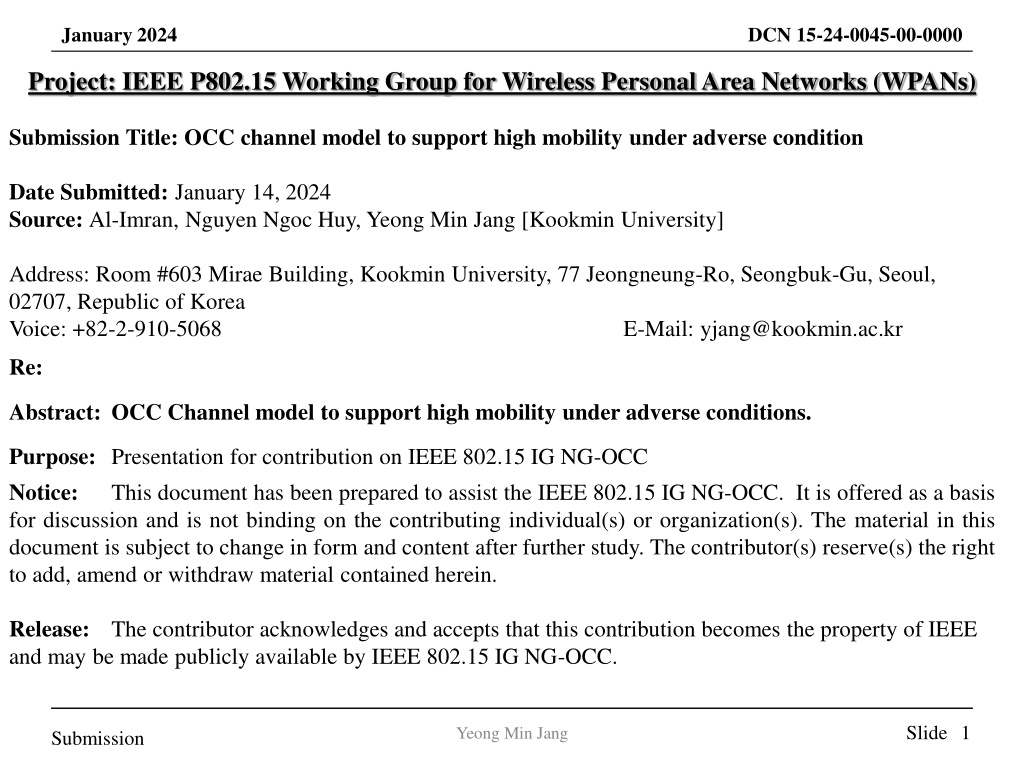
Optical Camera Communication: Channel Modeling for High Mobility
Explore the OCC channel model supporting high mobility under adverse conditions for IEEE 802.15 WPANs. Discuss the fundamentals of channel modeling, machine learning-based channel estimation, and environmental-specific models. Dive into the innovative world of Optical Camera Communication (OCC) and its significance in wireless communication system design.
Download Presentation

Please find below an Image/Link to download the presentation.
The content on the website is provided AS IS for your information and personal use only. It may not be sold, licensed, or shared on other websites without obtaining consent from the author. Download presentation by click this link. If you encounter any issues during the download, it is possible that the publisher has removed the file from their server.
E N D
Presentation Transcript
January 2024 DCN 15-24-0045-00-0000 Project: IEEE P802.15 Working Group for Wireless Personal Area Networks (WPANs) Submission Title:OCC channel model to support high mobility under adverse condition Date Submitted: January 14, 2024 Source: Al-Imran, Nguyen Ngoc Huy, Yeong Min Jang [Kookmin University] Address: Room #603 Mirae Building, Kookmin University, 77 Jeongneung-Ro, Seongbuk-Gu, Seoul, 02707, Republic of Korea Voice: +82-2-910-5068 E-Mail: yjang@kookmin.ac.kr Re: Abstract:OCC Channel model to support high mobility under adverse conditions. Purpose: Presentation for contribution on IEEE 802.15 IG NG-OCC Notice: This document has been prepared to assist the IEEE 802.15 IG NG-OCC. It is offered as a basis for discussion and is not binding on the contributing individual(s) or organization(s). The material in this document is subject to change in form and content after further study. The contributor(s) reserve(s) the right to add, amend or withdraw material contained herein. Release: The contributor acknowledges and accepts that this contribution becomes the property of IEEE and may be made publicly available by IEEE 802.15 IG NG-OCC. Slide 1 Yeong Min Jang Submission
January 2024 DCN 15-24-0045-00-0000 OCC channel model to support high mobility under adverse condition January 14, 2024 Slide 2 Yeong Min Jang Submission
3 January 2024 DCN 15-24-0045-00-0000 Outline Introduction Optical Camera Communication Channel Modeling Non line of Sight (nLOS) Slide 3 Yeong Min Jang Submission
4 January 2024 DCN 15-24-0045-00-0000 Introduction Optical Camera Communication (OCC) is a novel form of optical wireless communication that utilizes the camera and image sensor capabilities of electronic devices to transmit and receive data using modulated light signals. Channel modeling is a fundamental aspect of wireless communication system design. It refers to the process of creating mathematical or statistical models to simulate the behavior and characteristics of a communication channel. Environmental-Specific Models: 1. Indoor Model Line of Sight (LOS) Non-line of Sight (nLOS) Diffuse 2. Outdoor Model Slide 4 Yeong Min Jang Submission
5 January 2024 DCN 15-24-0045-00-0000 Channel Modeling Machine Learning Based Channel Estimation Conventional Channel Estimation Deep learning based (3) Least Square Estimation (LS)(1) Conventional Neural Network based (4) Least Minimum Mean Squared Error (LMMSE)(2) Deep Residual Learning (5) FFDNet-based (6) Maximum Likelihood Estimation (ML) ResCBDNet References 1.Y. S. Hussein, M. Y. Alias, and A. A. Abdulkafi, On performance analysis of LS and MMSE for channel estimation in VLC systems, in Proc. IEEE 12th Int. Colloq. Signal Process. Appl. (CSPA), Melaka, Malaysia, 2016, pp. 204 209. 2.X. Shi, S.-H. Leung, and J. Min, Adaptive least squares channel estimation for visible light communications based on tap detection, Opt. Commun., vol. 467, Jul. 2020, Art. no. 125712 3. C.-J. Chun, J.-M. Kang, and I.-M. Kim, Deep learning-based channel estimation for massive MIMO systems, IEEE Commun. Lett., vol. 8, no. 4, pp. 1228 1231, Aug. 2019. 4. G. Fan, J. Sun, G. Gui, H. Gacanin, B. Adebisi, and T. Ohtsuki, Fully convolutional neural network-based CSI limited feedback for FDD massive MIMO systems, IEEE Trans. Cogn. Commun. Netw., vol. 8, no. 2, pp. 672 682, Jun. 2022 5. C. Liu, X. Liu, D. W. K. Ng, and J. Yuan, Deep residual learning for channel estimation in intelligent reflecting surface-assisted multiuser communications, IEEE Trans. Wireless Commun., vol. 21, no. 2, pp. 898 912, Feb. 2022. 6.Z. Gao, Y. Wang, X. Liu, F. Zhou, and K.-K. Wong, FFDNet-based channel estimation for massive MIMO visible light communication systems, IEEE Wireless Commun. Lett., vol. 9, no. 3, pp. 340 343, Mar. 2020. . Slide 5 Yeong Min Jang Submission
6 January 2024 DCN 15-24-0045-00-0000 Channel Modeling Difference between conventional and machine learning base channel estimation a. Using ML for channel estimation can offer advantages in scenarios where traditional methods may struggle to adapt to changing and complex channel conditions like (atmospheric turbulence or mobility of optical sources). DRL algorithms have the capability to learn and adapt to non-linear and non-stationary channel conditions, which may be difficult for traditional estimation techniques such as Least Squares Estimation, Maximum Likelihood Estimation (MLE) that assume linearity and stationarity. b. c. Traditional estimation methods may assume Gaussian noise(electronic and thermal noise). which may not accurately represent real-world noise characteristics in FSO/OCC systems. ML can learn to handle non-Gaussian noise distributions(Atmospheric turbulence). d. Traditional methods often rely on assumptions about the channel, noise, or environmental conditions. ML, being a model-free approach, can learn directly from data without making strong assumptions. Slide 6 Yeong Min Jang Submission
7 January 2024 DCN 15-24-0045-00-0000 Non-Line of Sight (non-LOS) For non-directed LOS and diffuse links, the optical path loss is more complex to predict since it is dependent on a multitude of factors, such as room dimensions, the reflectivity of the ceiling, walls and objects within the room, and the position and orientation of the transmitter and receiver, window size and place and other physical matters within a room. The reflection characteristics of object surfaces within a room depend on several factors including, the transmission wavelength, surface material, the angle of incidence i and roughness of the surface relative to the wavelength. System setup of the NLOS OCC testbed. Slide 7 Yeong Min Jang Submission
8 January 2024 DCN 15-24-0045-00-0000 Non Line of Sight (non-LOS) ??(?+1) 2??2cos?( )cos ?,? 0 ?????????= ? ??????= ????+ ????? Slide 8 Yeong Min Jang Submission
9 January 2024 DCN 15-24-0045-00-0000 MIMO in OCC Recently, MIMO technology has also been applied to NLOS-OCC to improve system throughput. Similarly with visible light communication, the applications and service of camera are combination of lighting purpose and communication function. In addition, there are still a few challenges in NLOS-OCC including (i) higher levels of attenuation due to diffuse reflections, thus lower signal to noise ratio (SNR); (ii) increased levels of interference due to light signals from other sources. Slide 9 Yeong Min Jang Submission
10 January 2024 DCN 15-24-0045-00-0000 MIMO in OCC Description Notation Value In our experiment, an m-MIMO VLC system is considered with Nt light-emitting diodes (LEDs) as the transmitters and Nr photodetectors (PDs) as the receivers. It is assumed that the specifications and performance of all LEDs are identical, as are the PDs. The size of the room Lr x Wr x Hr 6 x 6 x 3 Transmitter semi- angle 30 LED power P 0.02W The m-MIMO channel matrix is denoted by H with the dimension of Nr Nt, is the responsivity of the PD (in Amperes/watt), and Nr 1 vector N represents real- valued AWGN including the ambient light shot noise and thermal noise with zero mean and variance. Nr Nt = 100 x 100 FOV of the PD 45 1 c?2 Physical area of PD Ar Refractive index of OC n 1.5 Slide10 Yeong Min Jang Submission
January 2024 DCN 15-24-0045-00-0000 Reference [1] G. Fan, J. Sun, G. Gui, H. Gacanin, B. Adebisi, and T. Ohtsuki, Fully convolutional neural network-based CSI limited feedback for FDD massive MIMO systems, IEEE Trans. Cogn. Commun. Netw., vol. 8, no. 2, pp. 672 682, Jun. 2022. [2] J. Fan, P. Liang, Z. Jiao, and X. Han, A compressive sensing and deep learning-based time-varying channel estimation for FDD massive MIMO systems, IEEE Trans. Veh. Technol., vol. 71, no. 8, pp. 8729 8738, Aug. 2022. [3] A. Yesilkaya, O. Karatalay, A. S. Ogrenci, and E. Panayirci, Channel estimation for visible light communications using neural networks, in Proc. Int Joint Conf. Neural Netw. (IJCNN), 2016, pp. 320 325. Slide 11 Yeong Min Jang Submission




